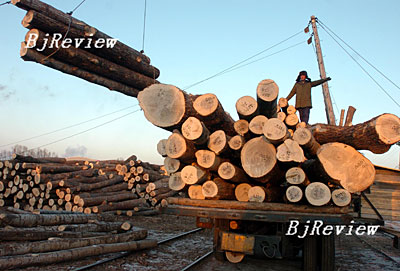|

Zhang Chunyu, who had planned a home improvement project for his new apartment, recently discovered that prices for solid timber flooring and solid wood furniture had jumped during the Spring Festival.
"Prices for almost any brand of wood products have increased at least 10 percent," Zhang said. "Prices for mid-range furniture have gone up by as much as 20 percent. Had we placed orders before the festival, we would have saved a large amount of money."
Rises in the cost of timber and labor have led to rises in the price of solid timber flooring in home improvement centers such as Lanjing-Lijia and Orient Home in Beijing. Timber prices generally increased by 10-20 percent in the weeks around the festival. Prices for solid wood furniture also increased due to a shortage of imported raw material timber and in anticipation of the consumption tax increase on solid timber flooring as of April 1, 2008.
"I can assure you that there will be a new round of price hikes this month," Zhang Yin, Store Manager at Lanjing-Lijia told Beijing Review. "Prices of solid wood doors will also increase because the prices for raw timber had already risen when factories bought timber from wholesalers in northeast China before the festival."
Statistics from China Timber Distribu-tion Association (CTDA) show that prices for Mongolian Scotch pine logs increased by 12 percent, and prices for lacebark pine logs went up by 11.5 percent last year. The two types of timber are the most frequently used in China's furniture industry and timber price hikes contributed to a 10-15 percent increase in the average price for solid timber flooring in 2007.
According to predictions from CTDA, timber prices will continue to soar this year. Aside from the escalation of the consumer price index (CPI), the acute scarcity of timber also factors into the rise. China has sharply restricted domestic logging and the supply of imported timber from Russia and other countries is limited. Furthermore, the demand for raw timber keeps growing in the papermaking industry as enterprises strive to expand their production capacity.
Of all the raw materials needed by the pulp and paper industry in China, pulp, waste paper and non-wood pulp account for 65 percent. Non-wood pulp will be gradually replaced by pulp and waste pulp because of growing domestic consumption of paper products and the pollution by products produced by non-wood pulp, especially straw pulp. However, pulp production is far from meeting the demands of the papermaking industry due to the long-term shortage of a domestic timber supply. Even worse is the fact that waste paper recycling in China is not a standardized industry of high economic return and the quality of recycled paper is inferior to imported waste paper made of pulp. As a result, the industry depends on imported raw materials for production.
According to a report on global pulp prices from China Jianyin Investment Securities, the Chinese factor will disturb the six-year cycle of global pulp prices. Global pulp prices will stay high for quite some time due to the scarcity of forest resources and strong demand from China, though fluctuation is possible following changes in supply-demand relations in the international market.
Heavy snowstorms in south China early this year also aggravated the timber supply shortage in China. According to Zhu Lieke, Vice Administrator of the State Forestry Administration, about 46 million acres of forest in 19 provinces including Fujian, Jiangxi and Zhejiang were damaged by the snow disaster, accounting for 10 percent of the country's forest coverage. Economic losses for the forest industry reached 57.3 billion yuan ($8 billion) because of the storms.
Against this backdrop, saving energy resources is a must to ensure the sustainable development of the market. Take disposable chopsticks for example. They have become a necessity of urban life in the past 30 years. China's disposable chopstick factories churn out roughly 63 billion pairs each year, consuming nearly 1 million cubic meters of timber and 40 million bamboo trees. Yet, this is still not the major form of timber resource waste.
"The key is recycling," said Greenpeace forest campaigner Ma Lichao. "Differing from other products made of wood, disposable chopsticks are still not recycled in China."
In Japan, 99 percent of the disposable chopsticks are recycled and 30 pairs can be made into one piece of A4-sized paper or one postcard. "Disposable chopsticks are disposed as garbage in China, which is completely different from the practice in Japan," said Ma. "There is no equivalent disposal technology in China.
Recycling problems also exist in the papermaking industry. The demand for waste paper is expanding because 56 percent of waste pulp can be used in paper production in China now. Yet only 34.3 percent of waste paper can be recycled in China, far lower than the 70 percent in developed countries. Papermaking enterprises in China have to import waste paper to keep their machine busy. From 1996 to 2006, imported waste paper increased from 1.37 million tons to 19.62 million tons, up 1,300 percent, a major contributing factor in the global rise of prices for waste paper. | 